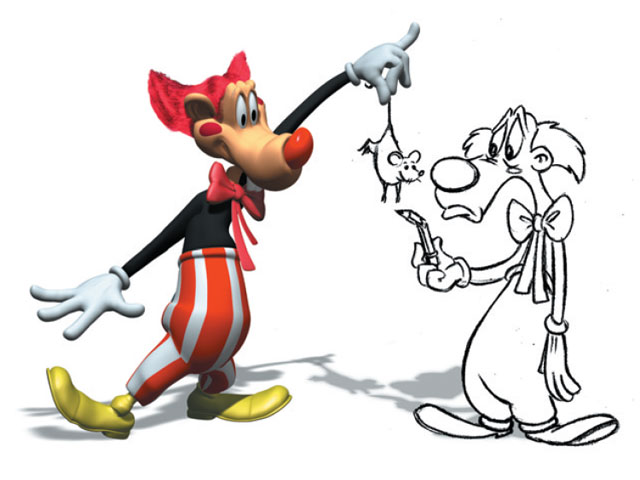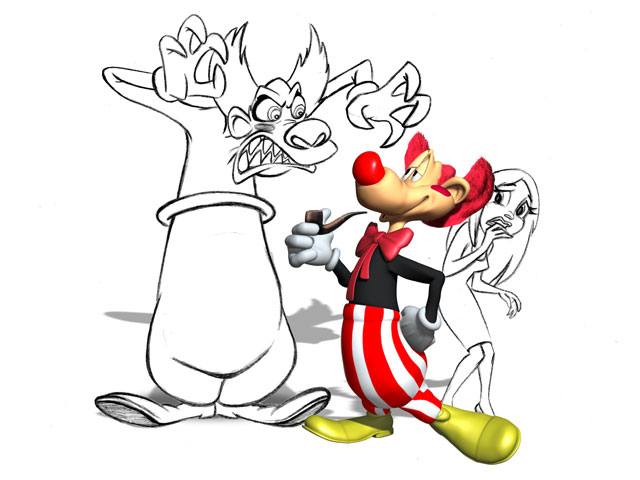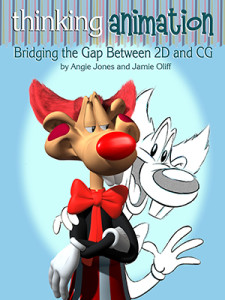
Book Showcase: Thinking Animation – Animation Mentor Interview
Click here to see the original interview
Animation Mentor: What inspired you to create the book?
Angie: I got the idea for this book while I was animating on Stuart Little 2 in 2001. The SL2 team was a majority of traditional animators hired from Disney and many of these guys were still grasping how to animate with a computer. In addition, we had two Animation Supervisors – Tony Bancroft and Eric Armstrong. Tony came from a traditional background and focused on performance and Eric took care of performance notes and all technical issues. So, we had both CG and traditional sides of animation at the helm of the show. During the course of production, the gap between animators who had used a computer and those who had not become very evident. In addition, much of the technical support on the show was overworked and couldn’t spend much time with these guys helping them with the tools. I watched many great animators struggle to get something out of the machine and understood what the traditional animators brought to the table…outside of pushing buttons within the software. So, I would try to help many of these animators figure out the graph editor and with their workflow, making them faster and letting them do what they are good at – animate!
 I thought to myself after that production, there needs to be some kind of text out there to help bridge this gap. There needs to be a book out there that can speak to those trying to cross over from traditional to CG and at the same time, the material would apply to young rising stars just entering the field of animation. I soon got busy with other productions and forgot about the idea until I had a conversation with my editor from a previous book – Steve Weiss – who encouraged me to make it happen. I met Jamie at that time and asked if he would be willing to work with me on the project and represent the traditional side of things. Thank goodness he said “Yes!” because his contribution is so incredible. The book would not have been the same without him.
I thought to myself after that production, there needs to be some kind of text out there to help bridge this gap. There needs to be a book out there that can speak to those trying to cross over from traditional to CG and at the same time, the material would apply to young rising stars just entering the field of animation. I soon got busy with other productions and forgot about the idea until I had a conversation with my editor from a previous book – Steve Weiss – who encouraged me to make it happen. I met Jamie at that time and asked if he would be willing to work with me on the project and represent the traditional side of things. Thank goodness he said “Yes!” because his contribution is so incredible. The book would not have been the same without him.
Animation Mentor: Tell us about the book.
Jamie: There are various books out there that teach you about the software, and many books that teach you the principles of animation. This book teaches you how to apply traditional principles and is written by working professionals who do just that. We have interviewed over 50 people coming from all sorts of backgrounds including stop-mo, traditional and CG. The contributors also range from directors, supervisors, story people and animators who have been working in animation for years. The chapters are broken out as; Introduction: Fleas on the Shoulders of Giants, Storytelling: Tell me a Story, Character: The Good, The Bad and the Just Plain Annoying, Thinking: The Thursday Animator, Animation: Every Frame Counts, Acting: Acting the Moment, Again and Again and Again, Studio Politics: When Push Comes to Stab and Conclusion: The End of the Beginning.
Angie:  There is also a forward written by both a 2D and CG pioneers (Floyd Norman and Richard Taylor) in the front matter of Thinking Animation. Floyd Norman has been animating since the ’50s and is a talented story man and animator. After a ten year absence from film, Floyd returned to his roots doing story work on several feature-length Disney animated films, Hunchback, Mulan, Tigger Movie, Dinosaur, and Toy Story 2. Richard Taylor organized the effects for the film TRON and was a key designer of the film’s graphics and costumes. Richard continues to work in CG as Cinematics Director at EA-LA. These two amazing artists help us tell the story of how we got here and what is next for animation. We also have a timeline at the footer of the book that begins in 1800 and goes to 2005 documenting all events in both traditional and computer-generated animation. History is so important to understand what field you have entered, following trends in the industry and learning how to stay employed, as those trends change. Jerry Beck and Tom Sito were generous with their input on the timeline and the production lists and charts in the back of the book that further explain events in the history of American animation. There are over 50 hand-drawn and computer-generated illustrations throughout the book that also add humor and show how much fun animation can be with the silly things we do on a normal day. There is also a section called the Animation Hall of Funny with quotes and comics from productions. We wanted the book to be informative and fun to read. For more information, we have chapter summaries located on the Thinking Animation Website where people can learn more about each chapter and what this book is about.
There is also a forward written by both a 2D and CG pioneers (Floyd Norman and Richard Taylor) in the front matter of Thinking Animation. Floyd Norman has been animating since the ’50s and is a talented story man and animator. After a ten year absence from film, Floyd returned to his roots doing story work on several feature-length Disney animated films, Hunchback, Mulan, Tigger Movie, Dinosaur, and Toy Story 2. Richard Taylor organized the effects for the film TRON and was a key designer of the film’s graphics and costumes. Richard continues to work in CG as Cinematics Director at EA-LA. These two amazing artists help us tell the story of how we got here and what is next for animation. We also have a timeline at the footer of the book that begins in 1800 and goes to 2005 documenting all events in both traditional and computer-generated animation. History is so important to understand what field you have entered, following trends in the industry and learning how to stay employed, as those trends change. Jerry Beck and Tom Sito were generous with their input on the timeline and the production lists and charts in the back of the book that further explain events in the history of American animation. There are over 50 hand-drawn and computer-generated illustrations throughout the book that also add humor and show how much fun animation can be with the silly things we do on a normal day. There is also a section called the Animation Hall of Funny with quotes and comics from productions. We wanted the book to be informative and fun to read. For more information, we have chapter summaries located on the Thinking Animation Website where people can learn more about each chapter and what this book is about.
Animation Mentor: Do you have any additional tips to share with our readers?”
 Jamie: No matter how much the business changes, technology-wise, I certainly believe that there is no replacement for a good knowledge of the basics. Great draftsmanship will always be held in high regard. The ability to describe your ideas quickly and clearly is paramount. Great drawing ability is without a doubt, the quickest way to get those ideas across. Always be open to new technology and what it can do for your art. Have an open mind and keep your eyes and ears open. There is so much to learn, both from the past and from the younger people entering the business with fresh ideas.
Jamie: No matter how much the business changes, technology-wise, I certainly believe that there is no replacement for a good knowledge of the basics. Great draftsmanship will always be held in high regard. The ability to describe your ideas quickly and clearly is paramount. Great drawing ability is without a doubt, the quickest way to get those ideas across. Always be open to new technology and what it can do for your art. Have an open mind and keep your eyes and ears open. There is so much to learn, both from the past and from the younger people entering the business with fresh ideas.
Angie: Carry a sketchbook with you at all times. I stopped doing this for a while and my work suffered from it. Jamie just gave me a new one for my birthday and encourages me to carry it with me all the time and I do. As far as animation specifically I say: Listen, Stay Honest, Experiment, Think, Intuit, Feel and Learn. Because your supervisor knows what the client wants. Because that is the only way you will get into his head and create a real performance. Break any and all rules to animation while following them to create something different about the shot and you cannot go wrong. Understand that you have something new to learn and share with others around you. Every frame counts, every finger, every eyelid shape, every arc, the line of action…everything. The details are just as important as the broad strokes. Remember this, if nothing else. We mention Animation Mentor in the book and think what the school is doing is excellent. If you are taking classes with AM, you are on the right track! Finally, drink lots of Diet Coke – I hear it has caffeine to keep you awake.
Animation Mentor: Where can our readers hear more and get their copy of the book signed?
 Angie: September 26th, 2006 we will be teaching a seminar at Disney Features through their Artistic Development Department including a panel with Floyd Norman, Richard Taylor, and Jerry Beck. By the Fall, we will have a schedule of public and private seminars, panels (including many of the contributors to the book) and speaking engagements on the Thinking Animation Website, so please check back for more on that.
Angie: September 26th, 2006 we will be teaching a seminar at Disney Features through their Artistic Development Department including a panel with Floyd Norman, Richard Taylor, and Jerry Beck. By the Fall, we will have a schedule of public and private seminars, panels (including many of the contributors to the book) and speaking engagements on the Thinking Animation Website, so please check back for more on that.
To purchase Thinking Animation: Bridging the Gap Between 2D and CG, please click here.
